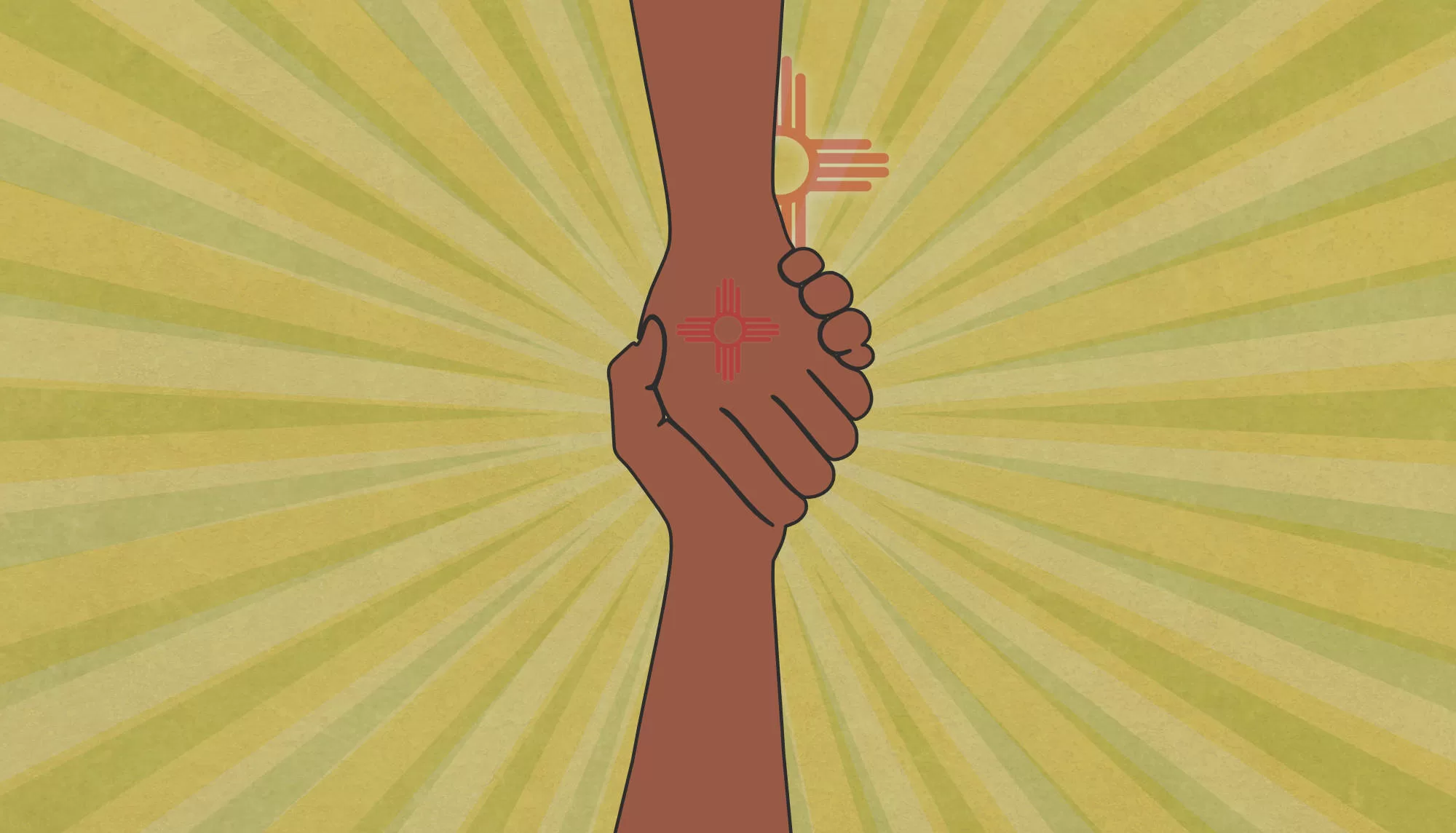Mentoring 100% of Our Children and Youth
We know the benefits of youth mentoring can include increased school engagement and achievement and a delay in the use of alcohol and other mind-altering substances. Explore how your county can meet the challenge of ensuring a mentor for every child and youth.
We asked David Sherman with New Mexico Big Brothers/Big Sister about the challenges his mentoring organization, and all similar programs, face as we emerge from the pandemic in our bold “build back better” phase.
Question: How did the pandemic impact mentoring?
David Sherman: The pandemic had a substantial and devastating impact on youth mentoring providers and the mentoring relationships that they support. Despite innovative program adaptations to provide virtual mentoring options and expanded services and supports, over 40% of existing mentoring relationships were unable to maintain consistent contact during COVID-19. Site-based programs, where the volunteer mentor meets with the mentee at a school or after-school site, fared even worse, with the vast majority of these relationships ending or being placed on hold due to school closures and volunteer restrictions. Referrals for services, and interest in volunteering also plummeted during the pandemic as people avoided in-person meetings and were hesitant to embrace “virtual mentoring” options like Zoom-facilitated meetings, letter writing, and projects worked on together via video platform or phone. There is still much to learn about the pandemic’s lasting impact on mentoring. However, it is clear that substantially greater numbers of young people are disconnected from their communities, schools, organizations, and the formal and informal mentoring relationships and opportunities that these organizations provide.
Question: What support does your organization and other mentoring programs require to begin to create a seamless system of youth mentoring across all 33 counties?
David Sherman: First and foremost, programs need numerous more mentors in order to create a more seamless system of youth mentoring across all counties and a sustainable funding source to support these relationships. Big Brothers Big Sisters, like many youth mentoring organizations, utilizes a volunteer mentor model. A common misconception is that this means it doesn’t cost anything to provide these services. While the volunteer time is a substantial in-kind investment (our expenses would more than double if we paid our Bigs to spend time with their Little), mentoring programs require structure and staff resources in order to recruit, enroll, screen, train, and support mentor/mentee relationships. We also need help getting the message out about the need for mentors to everyone in New Mexico. Imagine if ads calling for mentors were seen and heard at even 1-10th the rate of those we come across for cell phone carriers and insurance providers.
Question: What is the challenge to recruiting adults?
David Sherman: The biggest challenge in recruiting adults is overcoming concerns regarding the time commitment. This is tricky, because the time commitment is real. It does take 4-6 hours a month to participate in most mentoring programs, and in some instances it can require more than that. Add to that the fact that if the mentor fails to show up consistently and meet this commitment, it can be emotionally and socially damaging to the child. Hower, mentoring is also a rewarding experience and in most instances can be easily incorporated into your day to day life. This is further complicated by the fact that adults need to hear about the need for mentors tens of times before they are moved to act. Mentoring programs do not have the resources necessary to keep their program visible and top of mind at the frequency and scale needed to adequately meet the need for mentors.
Question: What are success stories with recruitment for school based and community based mentoring?
David Sherman: For school based mentoring, our High School Bigs program is a great way for high school students to serve as mentors to children at a neighboring elementary or middle school. The Littles benefit from the guidance, advice, and friendship of an older student who has recently been where they are and oftentimes looks like them. For high school students, it presents an opportunity to develop leadership and soft skills necessary to succeed in college and career. These programs can also be an effective way to provide mentoring services to children in less populated areas where recruiting adult mentors is a challenge.
Business partnerships are another way to successfully recruit volunteers to mentor in nearby schools. One such model developed nationally in partnership with Comcast is the Beyond School Walls Model. In this model, a business partners with Big Brothers Big Sisters and a nearby school providing financial support and employees to serve as mentors. Participating employees are matched one-to-one with students from the school for the duration of the school year. The program includes occasional visits to the mentor’s workplace to explore career opportunities, develop professional skills, and interact with classmates in a real-world office setting.
For community based recruitment, marketing campaigns that target a specific need tend to be successful. For these campaigns, it is important to include traditional media and social media sources and to engage donors, program advocates, and existing mentors in the campaign (since they tend to be the most reliable source of new volunteer referrals). Creating a sense of urgency is also helpful to get people to take the step of volunteering. For example, a plea for 30 volunteers in 30 days is more likely to be responded to than a general plea for volunteers.
Currently, our Big Futures Campaign focuses on reconnecting children through mentoring in three areas that we feel are particularly relevant in addressing children’s needs post COVID. The first is our Outdoor Mentoring initiative which seeks to connect children with a volunteer whom they participate in outdoor activities with, helping to reduce their screen time. The second is encouraging people to volunteer as a mentor at school. The third is our Bigs with Badges program which encourages first responders and those in the medical field to mentor a child in the community they serve.
Question: What role can the internet have in increasing mentoring?
David Sherman: The internet has the potential to make mentoring significantly more accessible. Through internet searches, social media, and resource sites like 10 Vital Services, it has never been easier to find and connect with a mentoring organization, provided that you have reliable access to the internet. At Big Brothers Big Sisters, we are also using the internet to streamline our application process, schedule appointments, and provide expanded training opportunities including webinars and on-demand videos and resources.
The internet also makes it more convenient for mentoring to take place virtually. Virtual mentoring is not a new concept. Mentoring relationships have been maintained via mail, phone, and email for as long as these technologies have been in existence (think pen pals). Over the past decade, several online platforms have emerged to facilitate mentoring relationships that often take place using a video platform, phone app, and/or chat feature. Such virtual relationships have the potential to expand access to mentoring significantly, especially in more sparsely populated areas where it is often more difficult to find mentors. Scientists working in a Lab in Los Alamos can mentor children living in Window Rock, Grants, Las Vegas, or Raton, for example, providing inspiration to a future generation of scientists. Virtual mentoring also has the benefit of convenience, allowing the mentor and mentee to connect at a time that works best for them and eliminating the need for travel or a place to meet. Virtual mentoring platforms have the benefit of adding structure to the relationship by way of preplanned activities, curriculum, and conversation prompts. They can also be monitored by professional staff for safety purposes and to help better support the relationship.
However, there are also several drawbacks to virtual mentoring. Virtual mentoring using a web-based platform requires that both parties have reliable access to the internet. The latest Census figures suggest that 73.7% of households have broadband connections, meaning one in four households do not have access which is well below the national average. More troubling is the fact that rural and tribal areas, areas that could most benefit from virtual mentoring, have significantly lower rates of access to broadband. “Zoom fatigue” is also a real thing. Mentors who spend all day on video conferences and meetings can be reluctant to log-on to connect with a child, and students can also be reluctant to login to connect when they already spend so much of their time online and on devices. Digital literacy also can be a challenge, especially for older mentors and younger mentees. Because online mentoring is relatively new, there are also few studies available that look at the efficacy of online virtual relationships.
In my view, the biggest potential to use the internet to grow mentoring is to offer online mentoring as a compliment or add on to more traditional forms of mentoring. Imagine if we could engage seasonal residents as mentors by having them visit with a mentee at a school or in the community while in town and virtually during the time they are away. Think of the number of mentors we could attract if entire workplaces agreed to participate in virtual mentoring programs allowing employees to meet virtually once a week and in person at the school or for an office field trip on occasion.
Question: Our kids’ lives have been disrupted for two years, leaving many feeling isolated and fearful. Why is mentoring more important than ever now?
David Sherman: Over the past two years, young people’s lives have been dramatically altered by the COVID-19 pandemic; time largely spent at home in isolation and disconnected from schools, friends, family, and their community. Considering that New Mexico ranks next to last in the nation in child welfare well being, the pandemic has exacerbated existing levels of anxiety, stress, and trauma already experienced by many children and families in our community. Heightened levels of economic instability, food insecurity, job loss, social isolation, illness, and grief have a devastating impact on the health and wellbeing of our children and families, makes parenting more challenging, and leaves our children more vulnerable to the threats of abuse and neglect.
Mentoring is one way to help create a safe, supportive, and positive developmental eco-system that gives our youth space to cope and grow. While there is no singular antidote that can fix or mitigate these challenges all at once, it is imperative that our communities come together to reconnect children and families to the resources, services, and opportunities we all need to thrive. Studies suggest that one in three young people will grow up without a positive adult mentor, and the relationship deficit is growing across too many communities. This past year alone, 20% of the young people served by Big Brothers Big Sisters reported losing contact with an important adult in their life. Imagine the difference we would make if tens of thousands of positive New Mexico adults stepped forward to make sure that every child in our communities had a mentor? New Mexico children could be supported to find their path in life, contribute positively to our community, and pay it forward as mentors to the next generation.
Question: Many parents do not know the benefits of mentoring. How do we increase public awareness of linking a child or youth with a caring mentor?
David Sherman: Mentoring increases self-confidence, social and emotional development, relationship skills, and academic and career achievement. Knowing that, you would think every parent would want their child to have a mentor. Yet messaging the benefits to parents is one of the biggest challenges that we face.
To start, we need to de-stigmatize mentoring programs and flip the mindset from “I am a good parent, my child doesn’t need a mentor” to “Because I am a good parent, I will make sure my child has a mentor.” It must also be stressed that the parent is a partner in the mentoring relationship. Every child needs and benefits from having a mentor, outside of immediate family, in their lives. Whether that mentor comes into their life through existing family and community relations or through an organized program like Big Brothers Big Sisters shouldn’t make a difference.
As a society, it is long past time that we prioritize mentors as essential, not just nice. Public officials, schools, community stakeholders, philanthropists, and influencers/celebrities must stepforward to advocate for mentoring and sufficient resources must be dedicated to ensure that the message is loud and ongoing. This should include media campaigns, grass root initiatives, and shifts in school and community policies and procedures. Rather than leave it to agencies like Big Brothers Big Sisters to seek out children in need of a mentor (and vise versa), schools, healthcare workers, social workers, and the like should offer referrals for mentoring services as a routine part of their intake or enrollment process. During this chaotic school year, many schools did not allow volunteer mentors to meet with their mentees even after schools opened back up because the mentor was considered “nonessential.” While not intentional, the message that sends to parents and the community is that mentoring is nice but not necessary. If we want parents to know about the importance and benefits of mentoring, should we be telling them that mentoring is essential and offering it as a way to help their child reconnect?
Question: What would be the best strategy for our 100% Mentoring action teams to use to create a county coalition focused on ensuring mentoring for all?
David Sherman: Utilizing and building on existing resources, 100% Mentoring action teams should encourage and incentivize collaboration. They should focus on identifying, strengthening, and building upon existing programs and resources where possible. In identifying needs and existing resources, it is critical to seek broad community representation that includes youth and family voices. The teams should also identify anchor institutions that can be used to establish, house, or grow mentoring services or otherwise serve as a backbone for support. Finally, the teams should advocate for mentoring, especially at the local level, and should challenge government officials and community stakeholders to commit resources to support mentoring and to include SMART goals to establish a steady and reliable source for mentors. At a minimum, this should include paid time off for mentoring, which we would describe as one of the most “family-friendly” policies a workforce, including local government, can have. Each county’s 100% Mentoring action team can play a pivotal role in creating robust mentoring programs for every rural and urban community.
Mission: The 100% New Mexico initiative is dedicated to ensuring that 100% of families can access ten vital services crucial for their overall health, resilience, and success. This university-sponsored endeavor necessitates the local implementation of evidence-based strategies encompassing both community and school-based service hubs, aiming to prevent the most pressing and costly public health and safety challenges, including adverse social determinants of health and adverse childhood experiences.
Don’t miss a blog post! Get notified!
The 100% New Mexico initiative is a program of the Anna, Age Eight Institute at New Mexico State University, College of Agricultural, Consumer and Environmental Sciences, Cooperative Extension Service. Contact: annaageeight@nmsu.edu or visit annaageeight.nmsu.edu to learn more.





